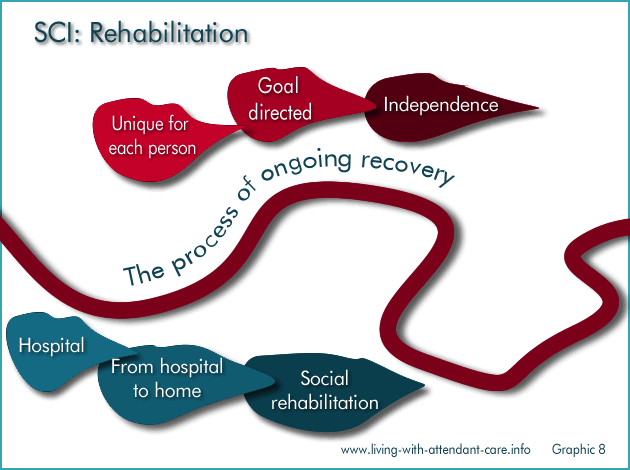- Spinal Cord Injury An introduction for people new to spinal cord injury
- What is spinal cord injury Understanding the essence of spinal cord injury
- Understanding spinal cord injury Where is the injury? C4, C6 . . .
- Injury, effects and impacts Injuries to the spine have effects on the nervous system that lead to impacts in people's lives
- Rehabilitation The rehabilitation process from injury to living in the community
- Adjusting to spinal cord injury People's experiences of having spinal cord injury
- Attendant care challenges Challenges for people with spinal cord injury receiving attendant care
Rehabilitation
Rehabilitation
Rehabilitation aims to facilitate ongoing recovery.
It is unique for each person. It is goal directed. It enables a person to become as independent as they possibly can.
The process of rehabilitation starts in the hospital and continues as the person with the injury moves from hospital to home. It then continues with the person living in their home & community for as long as needed for the person to become as independent as they possibly can.
Rehabilitation aims to facilitate ongoing recovery.
Rehabilitation enables a person to become as independent as they possibly can. The goal is for the person to return to their previous abilities, activities and way of life as much as they possibly can. It means enabling the person to live with their remaining abilities and develop strategies to enable them to compensate and overcome new difficulties.
The process of rehabilitation experienced by each person is unique. Just as a spinal cord injury is unique, the type of rehabilitation program the person is engaged in is uniquely tailored to target individual needs. Rehabilitation addresses specific areas of physical difficulty and adjusting to the injury. It also addresses broader areas of returning to work, getting about in the community, and adjusting to changes a person may experience following a spinal cord injury.
Rehabilitation goals can build on each other, for example managing transport before getting a job.
Rehabilitation is ongoing.
It may also be episodic - as new situations and opportunities arise.
Rehabilitation is not something that is done to the person, rather with the person.
Rehabilitation is based on working with the person to achieve things that matter to them. Therefore, for it to be successful, the individual needs to participate actively in the rehabilitation process. The type of rehabilitation offered needs to be meaningful and relevant to the person. This means the person, their culture, pre-injury lifestyle, family and environment are critical to ensuring the success of rehabilitation.
The person's abilities will determine how the person is able to participate in the rehabilitation process.
Where recovery to the person's pre-injury life pathway is not possible rehabilitation involves choosing another meaningful but different pathway to a life worth living.
Three stages of rehabilitation
For all types of injuries the three stages of rehabilitation are:
Stage 1: Acute rehabilitation
This acute stage involves initial management to ensure the person is medically stable. Acute rehabilitation normally occurs within hospital with a strong focus on physical recovery and regaining independent living skills.
Stage 2: Post-acute rehabilitation/community re-settlement
This stage involves managing the transition from hospital back home, and the ongoing process of rehabilitation that occurs after discharge. The focus of rehabilitation at this stage may include return to work or study, finding alternatives where this is not possible and relearning skills for community living.
Stage 3: Social rehabilitation
This is the long-term rehabilitation aimed at maintaining and enhancing the level of participation in community life (community integration).
Within these three stages there are:
- General rehabilitation processes and
- Specialist rehabilitation processes.
There are many rehabilitation pathways.
When a person has an SCI there are many different rehabilitation pathways depending on the location and seriousness of the injury and the point in the life span the injury occurred and the person's circumstances. For example:
- An adult with a serious spinal cord injury could have the following pathway: Hospital Spine Injury Rehabilitation Unit; discharge to supported accommodation; community rehabilitation services.


